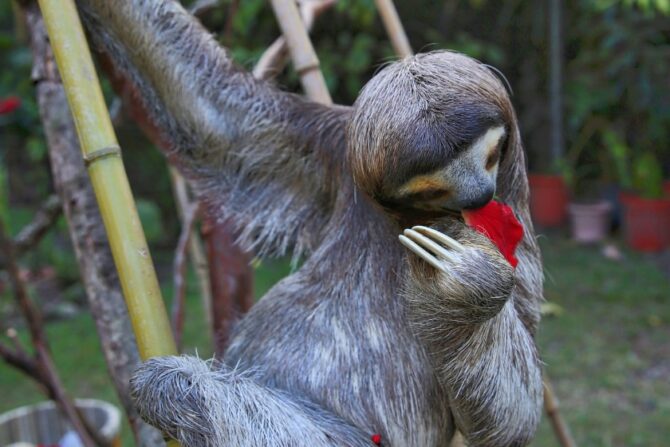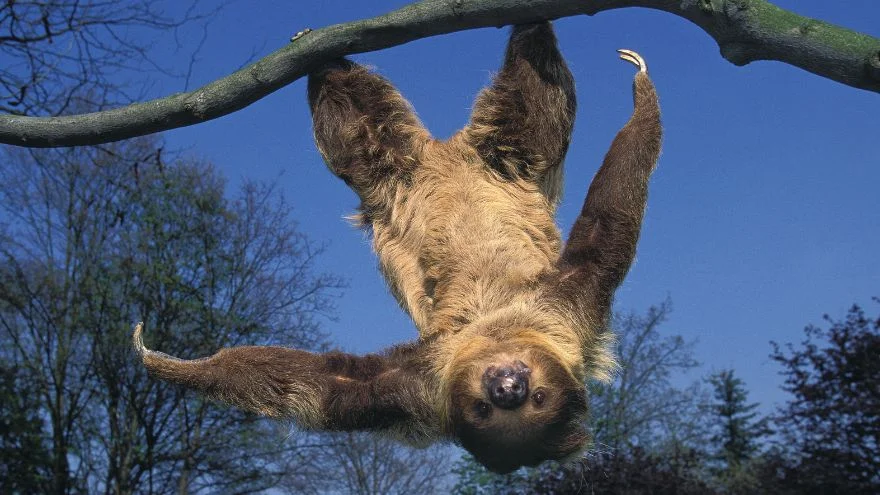What do Sloths eat? is a question many have wondered when they come across these lethargic creatures.
Known for hanging upside on trees, sloths live a life of minimal labor and thus in the harsh and unforgiving climate of the wilds, it may be quite intriguing to know these creatures feed healthily and live thrilling lives albeit one with low energy, in the wild.
Sloths mainly eat leaves, twigs, and buds but they have been known to consume insects, bird’s eggs, and lizards.
This article will explain what baby and adult sloths eat, their feeding behavior, and their place on the food chain.
What Do Sloths Eat?

All species of sloths are herbivores; specifically folivores. Folivores are animals that consume leaves primarily. They can also eat twigs and buds.
The three-fingered sloth may add seed pods to its diet; the two-fingered sloth has a more diversified that may include fruit. Occasionally, a sloth would eat insects, lizards, and bird eggs it comes across.
The leaves they consume are gotten from over 90 trees. That said, each sloth usually chooses about six to twelve trees it will eat from. Their choices are influenced by their mothers.
What Trees Do Sloths Eat?
Sloths are mostly associated with the Cecropia and as a matter of fact, these trees are vital for the reforestation programs that will rehabilitate the sloth’s natural environment.
However, sloths need much more variety in their habitats and food than this.
A few years ago, it was believed that these animals obtained all the water they needed from the plants they eat; that is no longer the case.
Global warming is drying up rainforests, making everywhere hotter, thus rendering it next to impossible for sloths not to drink water. They now find themselves having to migrate in search of cooler spots and water.
In 1975, Montgomery and Sinquist revealed 28 particular tree species and three lianas that serve as food for nine Brown-throated sloths.
Twenty years later in 1995, Quieroz listed 16 different plant species discovered in research carried out within the Mamiraùa reserve in the Amazon.
Three-fingered sloths diet
- Cacao husk and leaves (Theobroma cacao)
- Sangrillo (Pterocarpus officinales)
- Cecropia spp
- Colorado
- Chilamate (ficus insipide)
- Sapotaceans
- Bombacaceae
- Euphorbiaceae
- Moraceae (mulberry family or fig family)
- Apocynaceas (dogbane)
- Fig trees (ficus carica)
Two-fingered sloths
- Bobacaceae flowers
- Liana (annonaceae: trees, shrubs, and wild vines )
- Espavé or wild cashew (anacardium excelsum)
- Jobo (spondias dulcis or June plum)
What Do Captive Sloths Eat?
There are a significant number of sloths that live in captivity far away from their natural lush rainforest habitats.
It isn’t easy to procure the foliage that constitutes their meals; most zoos tend to feed them with whatever vegetation is accessible.
This can be vegetables, specifically root vegetables; flora from non-tropical climates that sloths digestive systems can’t assimilate.
Captive two-fingered sloths eat eggs, bananas, wildflowers, celery, boiled carrots, and bean sprouts. This diet is entirely too sugary for sloths and in the long run, they may contract heart disease or even diabetes.
It is supposed that their lifespans may be affected due to bad eating habits.
Nevertheless, this hypothesis can’t be taken as fact until some studies have been made comparing the lifespan of captive sloths and wild sloths.
What Do Baby Sloths Eat?
Sloths are placental mammals. During the first six months after they deliver, their offspring clings to their chest. This is to enable them to breastfeed intermittently during the day.
Female sloths do not store big quantities of milk in their breast for their young. Having so much breast milk weighs down on sloth mothers and requires way too much energy to carry around.
That said, they’ll instead produce small quantities of milk for their young seeing as the latter is constantly on its mother’s chest.
In addition to drinking milk, younger sloths start tasting leaves in their mother’s mouth at one week! This is because they are naturally curious and enjoy trying new things.
In this manner, they start learning which leaves are good for their consumption.
How Much Do Sloths Eat?
These animals consume minimal amounts of food daily. The regular weight of dry leaves eaten by any three-fingered sloth is about 2.5 ounces a day.
This is a small quantity compared to that of the howler monkey; this animal eats most of the leaves the sloth eats, they live in the same habitat, and they have the same size approximately.
The amount of food sloths eat depends on the ambient temperature; they have been known to consume a bit more food on warmer days.
However, there’s little change in food consumption between individual sloths and this certifies the assumption that sloths eating habits are well suited to their natural environment.
How Do Sloths Search For Food?
Sloths search for food by moving from tree to tree, consuming fresh leaves situated at the edge of branches from different trees.
This preference is because leaves from trees are not supposed to be eaten, they are simply meant to receive and process sunlight.
Matured leaves contain substances that accumulate over time and render them toxic when eaten in excess; hence the sloth’s decision to move from tree to tree.
How Do Sloths Digest Food?
Leaves are not formed by trees to be eaten but rather to receive and process sunlight. In light of this, they have very strong cell walls that contain large amounts of cellulose.
Also, older leaves retain certain substances that can make them very toxic when eaten in sizeable quantities.
Leaves don’t have many calories compared to other foods, so to make sure sloths have the energy they need, nature granted them special feeding habits and a unique digestive system.
Sloths prefer leaves that are on the edge of branches; these leaves are generally fresher. This choice is to avoid the toxins and thick cellulose contained in mature leaves.
To ensure a variety of food sources, sloths move from tree to tree. In this manner, they avoid accumulating poisonous substances in their bodies that may kill them over time.
They don’t extract nutrients directly from these leaves. Sloths have an intricate digestive system that allows the microorganisms in their belly to ferment and decompose the leaves.
They procure the calories and nutrients needed from these stomach microorganisms.
How Does the Temperature Affect Sloths’ Digestion?
Most mammals have microorganisms in their stomachs (gut bacteria) that enable digestion; they are very sensitive to changes in temperature.
That said, sloths are poikilotherms which means that compared to other mammals, their body temperature fluctuates.
Alternatively, the normal temperature of their natural habitat influences their temperature thus determining how warm and cold they are.
This is nature’s way of helping sloths conserve their energy and keep them hidden from predators that can track prey using heat radiation (detecting temperatures that deviate from the normal temperature).
FAQs
- How do sloths eat their food?
Sloths munch down on leaves. Because they lack incisors, they shorten these leaves by smacking their lips together.
- Why are sloths slow?
Sloths have a leafy, low-calorie diet as added to a slow metabolism. The speed at which they metabolize food is estimated at 40 – 45%, which is considered minimal.
This forces them to manage their energy which equates to moving as little as possible.
- Do sloths have predators?
Like all other herbivores, sloths are prey to other animals. These animals include harpy eagles, omelets, and jaguars.
Conclusion
Sloths are folivores that will consume the occasional insect. They are extremely slow and it is a wonder that they have survived on Earth for over 65 million years.
However, it would seem that this behavior of theirs is an evolutionary tactic that helps them hide from their predators through camouflage.
With these intriguing facts about sloths diets, we effectively answer the mind-boggling question what do sloths eat?

